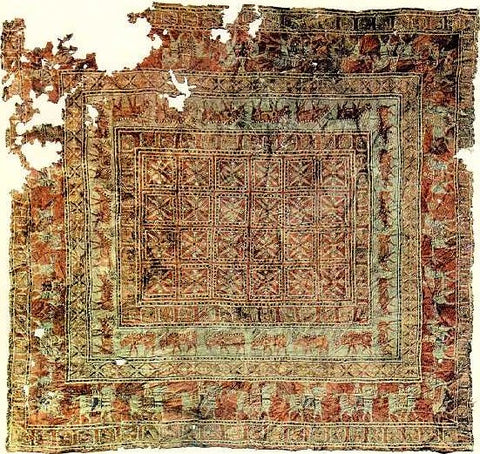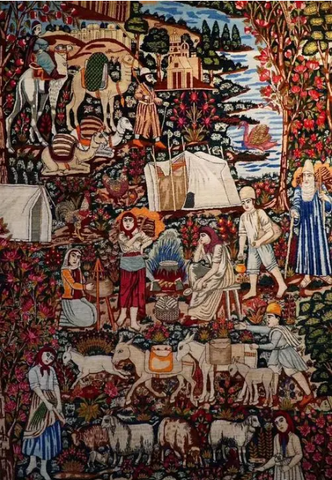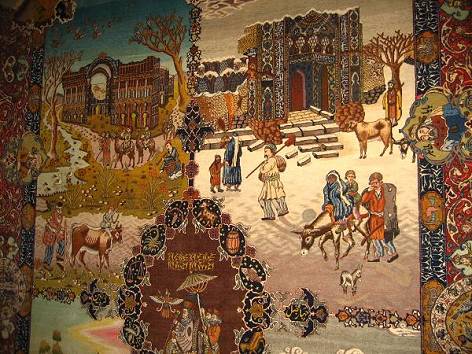Available for purchase in the USA
US

The origins of rug production are shrouded in mystery, with no exact known origin. However, many believe that it was born out of the needs of nomadic life, and developed independently in different parts of the world throughout history. 3000 BC, the residents of the Nile River Basin in North Africa weaved linen carpets and decorated them with brightly coloured cloth; from 1449 to 1423 BC, Egypt made colourful jacquard carpets; from 558 to 529 BC, there is a purple-red Babylonian carpet in the burial of Cyrus the Great, who unified Persia. Then, about 400 BC, an "8"-shaped knotted carpet appeared in Siberia.
In this blog, we will explore the fascinating history of rugs and their evolution over time, as well as the future of this timeless flooring option. We will also highlight the benefits of modern innovations, such as Matace removable carpet tiles, which offer convenience and practicality without sacrificing style or durability.

Woven rugs appeared earlier than flocked rugs. The technology of weaving rugs can be traced back to at least 2000 BC. Rug fragments from the 7th century BC have been unearthed near the Turkish capital Ankara. In 1949, archaeologists found a well-preserved flocked rug in a tomb built in the 5th century BC in the Altai Mountains. This is the famous Bazelek carpet. The Bazelek carpet is 1.83 meters wide and 2 meters long. The whole pattern has two large sides and 24 small squares in the center. Each small square has a small pattern. There are deer and oxen in the first big side, and in the second big side there is a team of ancient horse-riding warriors, forming two continuous patterns, which are also rare high-end carpets by current standards. This remarkable artifact offers a glimpse into the skill and artistry of ancient rug makers and their influence on the evolution of rug production.

After the last king was assassinated during the Sassanid Empire (226-642), the invading Arabs found a 7.8-square-meter carpet in the palace with flowers, trees, and crooked creeks decorated with carefully inlaid pearls and gems designed to enable the king to enjoy the warmth of spring in the long winter. This is the famous "spring carpet." Because Muslims pray every day, Islamic villages and tribes often weave their totems on prayer blankets, and the colors and patterns are also passed down from generation to generation. They are dyed according to recipes handed down from ancient times. The loom used for weaving carpets is also very suitable for the relocation of nomadic tribes. It is easy to disassemble and install. Many women and children were engaged in weaving carpets, and sometimes several people would be on the same loom, weaving according to the patterns sung by the leader. A smart leader would often have hundreds of patterns in mind.

Persian carpets from the 16th century are well-known in Europe for their charming patterns and colors. Many carpets have become treasures in the hands of major museums and collectors around the world, and are reflected in Italian paintings. The world-famous hunting carpets, courtyard carpets, and vase carpets were formed during this period.

The oriental carpets were introduced to England in 1254. At that time, King Edward I of England married the Queen of Spain. The queen brought many oriental carpets and Spanish carpets with her, which had a great influence on the British upper class, and the use of oriental carpets became a fashion. At the same time that a large number of oriental carpets were imported, they began to be imitated, and real British carpets appeared.

China, located in the east of the Silk Road, learned its hand-woven carpet weaving technology as introduced to the West in ancient times. It is a part of the origin of carpets as well. Some ethnic minorities in border areas also made hand-woven carpets and dedicated their exquisite products to the imperial palaces and nobles. In the Western Han Dynasty, more than 1,800 years ago, with the introduction of Buddhism, the Tibetan people used cattle and wool to make pads for worshiping Buddha and later made blankets for use, thus forming a budding carpet industry.
The woven vinyl has the look and feel of tightly woven natural sisal or seagrass, but is waterproof, non-slip and incredibly hard wearing. Woven vinyl is a material of the future. You may have seen woven vinyl fabrics in galleries, luxury cars, and luxury cruises. Today, Matace uses its unique backing technology to upgrade woven vinyl to become your residential indoor & outdoor rugs.
In conclusion, rugs have a rich history that dates back centuries and have evolved to become a staple in interior design. From traditional hand-woven rugs to modern, machine-made options, there are endless possibilities when it comes to incorporating rugs into your home or business. However, with the advancement of technology and the growing demand for more convenient and sustainable solutions, products like Matace removable carpet tiles offer a new level of flexibility and durability. They not only provide the benefits of traditional rugs but also offer easy installation, maintenance, and replacement. As we look to the future of interior design, products like Matace carpet tiles or woven vinyl rugs will continue to play an important role in meeting the evolving needs and preferences of consumers.
Leave a comment